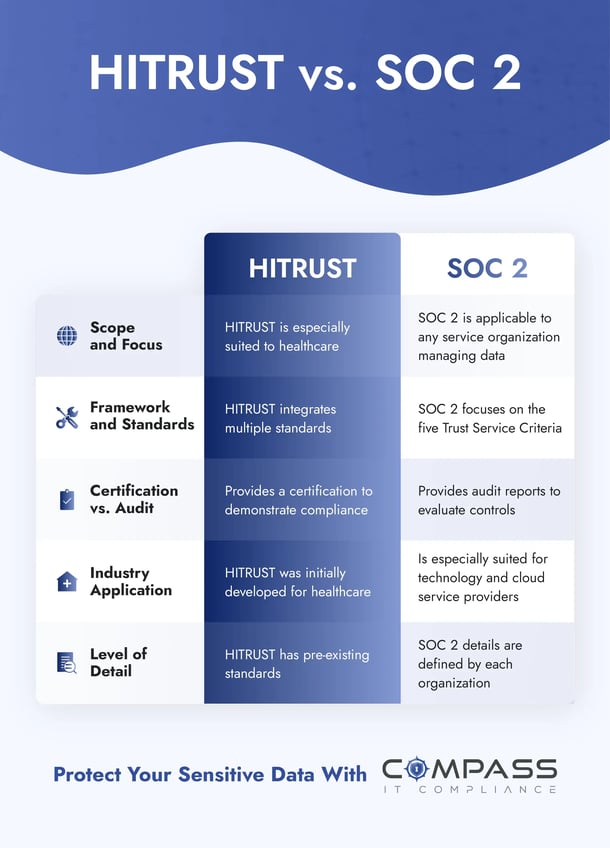HITRUST Certification vs. SOC 2: A Simple Comparison
As organizations prioritize data security and privacy, they often seek out certifications and audits that demonstrate their methodology to protect sensitive information. Two frameworks in this context are HITRUST Certification (Health Information Trust Alliance) and SOC 2 (Service Organization Control 2). While both aim to ensure data security and compliance, they differ in scope, application, and industry focus. This blog post provides a comparison of HITRUST vs. SOC 2, highlighting their differences and similarities.
Overview of HITRUST Certification
HITRUST is a certification framework that was developed by healthcare and IT professionals to address the regulatory requirements of the healthcare industry. It integrates various standards, including ISO, NIST, HIPAA, and COBIT, into a comprehensive set of controls known as the HITRUST CSF (Common Security Framework). The HITRUST CSF is a methodology to help organizations manage risk, improve their security posture, and comply with relevant regulations.
Key Features of HITRUST Certification
- Industry Focus: Aimed at healthcare organizations, but applicable to any industry seeking security and compliance measures.
- Comprehensive Framework: Integrates multiple standards and regulations, providing a unified approach to security and compliance.
- Certification Levels: Offers multiple levels of certification to accommodate organizations of size, complexity, and maturity levels.
- Risk Management: Emphasizes risk management and continuous improvement through periodic assessments and updates.
Overview of SOC 2
The SOC 2 is an auditing standard developed by the American Institute of CPAs (AICPA) for service organizations. It focuses on five Trust Service Criteria: Security, Availability, Processing Integrity, Confidentiality, and Privacy. SOC 2 reports evaluate and report on the effectiveness of a service organization’s internal controls related to these criteria.
Key Features of SOC 2
- Industry-Agnostic: Applicable to any service organization, regardless of industry, which handles customer data.
- Trust Service Criteria: Evaluates controls based on specific criteria, ensuring a targeted assessment of critical areas.
- Types of Reports: Offers Type I (a point-in-time assessment) and Type II (a period-of-time assessment) reports.
- Third-Party Assurance: Provides independent assurance from a third-party auditor, enhancing trust and credibility.

Difference Between HITRUST and SOC 2
Scope and Focus
- HITRUST: Designed to address comprehensive security and compliance needs, especially in healthcare. It covers a broad range of regulatory requirements and integrates multiple standards.
- SOC 2: Primarily focuses on the five Trust Service Criteria and is more general, applicable to any service organization managing data.
Framework and Standards
- HITRUST: Based on the HITRUST CSF, which integrates IT frameworks and standards (e.g., ISO, NIST, HIPAA).
- SOC 2: Based on the AICPA’s Trust Service Criteria, without integrating other standards directly. Organizations can choose which criteria to include in their assessment.
Certification vs. Audit
- HITRUST: Provides a certification that demonstrates compliance with the HITRUST CSF.
- SOC 2: Provides an audit report (Type I or Type II) that evaluates the effectiveness of controls based on the chosen Trust Service Criteria.
Industry Application
- HITRUST: Initially developed for healthcare but can be applied to other industries.
- SOC 2: Universally applicable across various industries, especially useful for technology and cloud service providers.
Level of Detail
- HITRUST: In-depth and prescriptive, requiring adherence to specific controls and practices.
- SOC 2: More flexible, allowing organizations to define and implement controls that meet the Trust Service Criteria.
Similarities Between HITRUST Certification and SOC 2
Data Security and Privacy
Both HITRUST Certification and SOC 2 emphasize the importance of data security and privacy. They require organizations to implement controls that protect sensitive information and ensure the confidentiality, integrity, and availability of data.
Third-Party Validation
Both frameworks involve third-party validation to provide assurance of compliance and effectiveness. HITRUST certification requires assessment by a HITRUST-approved assessor, while SOC 2 requires an audit by a CPA firm.
Risk Management
Both HITRUST and SOC 2 frameworks emphasize risk management. Organizations are required to identify, assess, and mitigate risks to ensure the security and privacy of data.
Continuous Improvement
Both HITRUST and SOC 2 promote continuous improvement. HITRUST requires periodic reassessments and updates to the CSF, while SOC 2 Type II reports evaluate the effectiveness of controls over a period, encouraging ongoing compliance and improvement.
Choosing Between HITRUST Certification and SOC 2
The decision to pursue HITRUST Certification or SOC 2 depends on several factors, including industry, regulatory requirements, and specific business needs.
For Healthcare Organizations
HITRUST Certification is often the preferred choice for healthcare organizations due to its comprehensive approach to regulatory compliance and security. It addresses the specific needs of the healthcare industry and integrates relevant standards, making it a robust solution for managing compliance.
For Technology and Service Providers
SOC 2 is commonly chosen by technology companies, cloud service providers, and other service organizations that manage customer data. Its flexibility and industry-agnostic nature make it suitable for a wide range of businesses seeking to demonstrate their commitment to data security and privacy.
Cost and Resource Considerations
The HITRUST Certification can be more resource-intensive and costly due to its comprehensive nature and detailed requirements. SOC 2, on the other hand, can be more cost-effective and flexible, allowing organizations to tailor the scope of the audit based on their specific needs.
Customer and Partner Requirements
Organizations should also consider the expectations and requirements of their customers and partners. Organizations may require HITRUST Certification due to its specific relevance to healthcare, while others may accept or prefer SOC 2 reports.
The HITRUST Certification and SOC 2 both play individual roles in ensuring data security and compliance. While they have distinct differences in scope, application, and industry focus, they share common goals of protecting sensitive information and providing assurance of security practices. Organizations should evaluate their specific needs, industry requirements, and resources to determine which framework is best suited for their compliance and security objectives. By understanding the differences and similarities between HITRUST and SOC 2, businesses can make informed decisions that enhance their security posture and build trust with their stakeholders.
Closing Thoughts
In comparing SOC 2 vs HITRUST, this article has highlighted their differences in scope, focus, and application. SOC 2 audits are versatile, designed for any service organization handling customer data, focusing on five Trust Service Criteria. Conversely, HITRUST Certification is tailored for the healthcare sector but is applicable to other industries, incorporating various standards into the HITRUST CSF. For organizations seeking to transition from SOC 2 to HITRUST, the SOC 2 to HITRUST mapping process is crucial, as it aligns SOC 2 controls with HITRUST requirements. Both frameworks emphasize data security, third-party validation, risk management, and continuous improvement, though they cater to different industry needs and compliance landscapes.
Compass assists organizations in navigating the complexities of IT security and compliance frameworks. By offering comprehensive SOC 2 reporting services, Compass supports clients through all stages of the compliance journey, from initial assessment to final audit. Our expertise ensures that your organization meets rigorous security standards and regulatory requirements, fostering trust and confidence among stakeholders. For tailored assistance and to learn more about our services, please contact us.
Contact Us
Share this
You May Also Like
These Related Stories

Understanding the Difference Between HIPAA & HITRUST

SOC 2 vs. NIST: A Comprehensive Comparison

.webp?width=2169&height=526&name=Compass%20white%20blue%20transparent%202%20website%20(1).webp)
-1.webp?width=2169&height=620&name=Compass%20regular%20transparent%20website%20smaller%20(1)-1.webp)
No Comments Yet
Let us know what you think